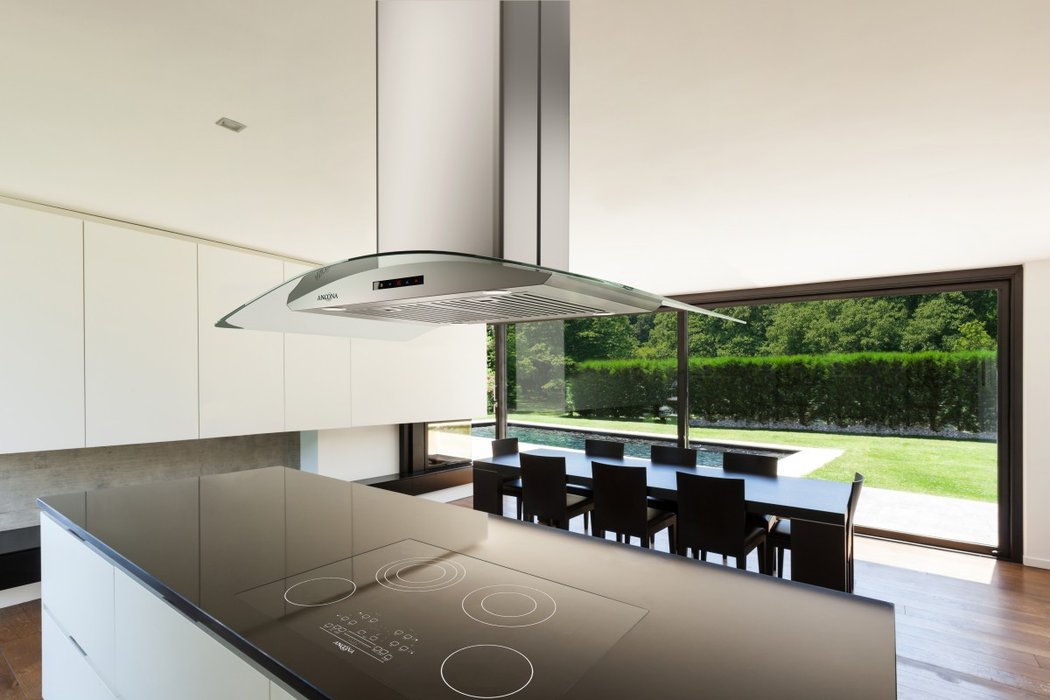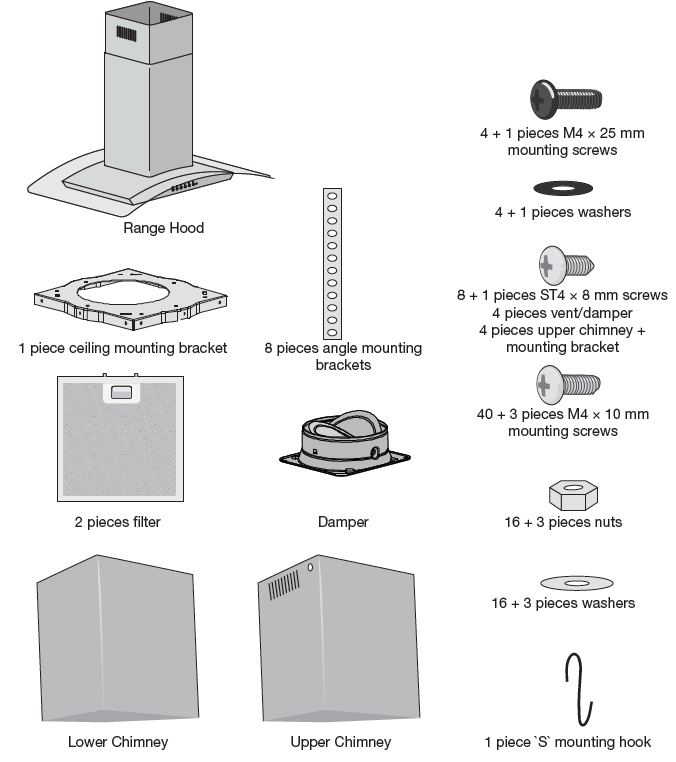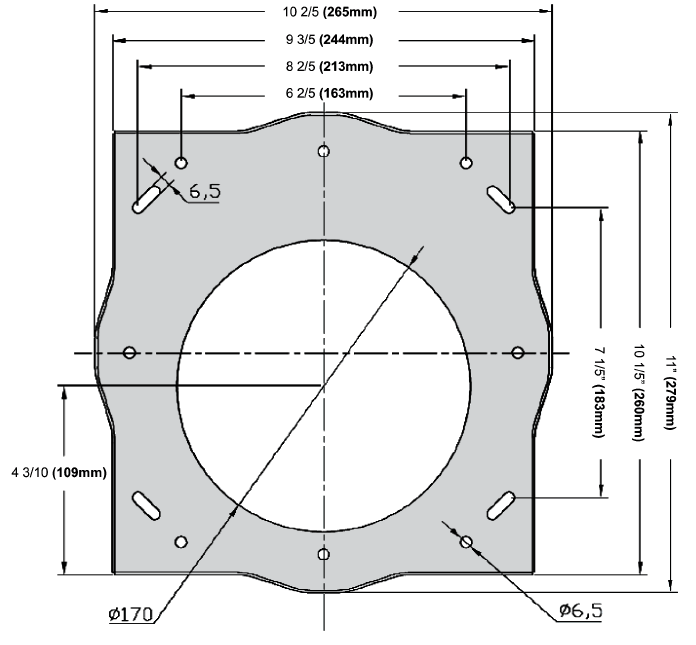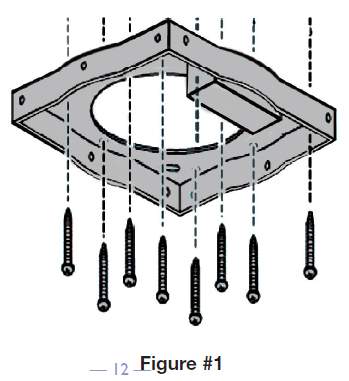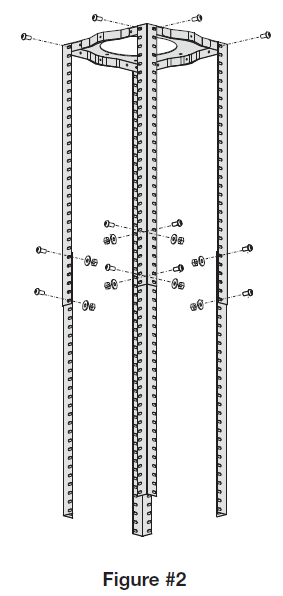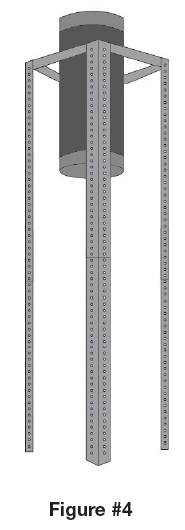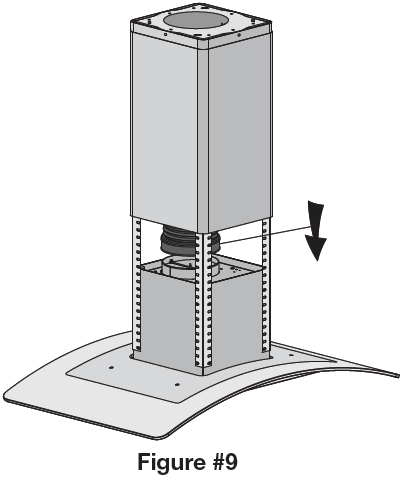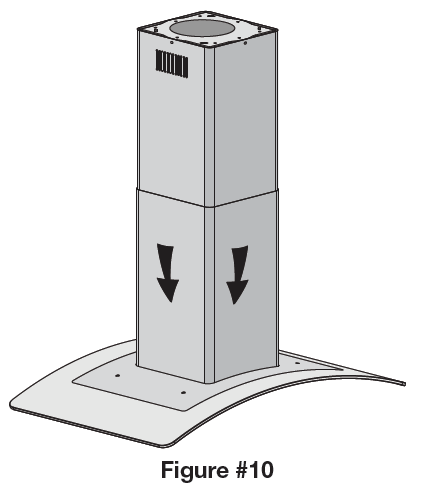ancona Island Range Hood
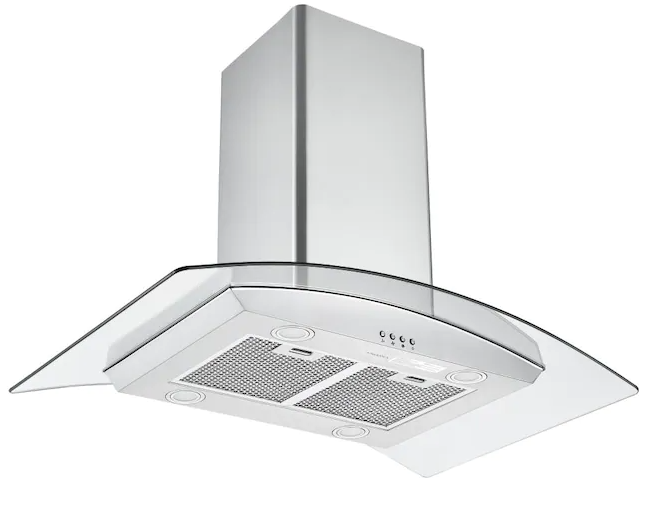
Before You Begin
INSTALLERS – Start Here
Safety Instructions are on pages 4 and 5 and Installation Instructions are on pages 9 to 15. Please perform these steps:
Please perform these steps:
- Read the safety instructions.
- Read all instructions in the Installation section of this manual BEFORE installing the range hood.
- Remove all packing materials.
- When finished, make sure to leave these instructions with the consumer.
- Installation is to be done by a qualified technician only. However, the ultimate responsibility for proper installation falls to the owner.
- Product failure due to improper installation is not covered under the Warranty.
CONSUMERS – Start Here
Safety Instructions are on pages 4 and 5 and Operating Instructions are on pages 16, 17, 20 and 21.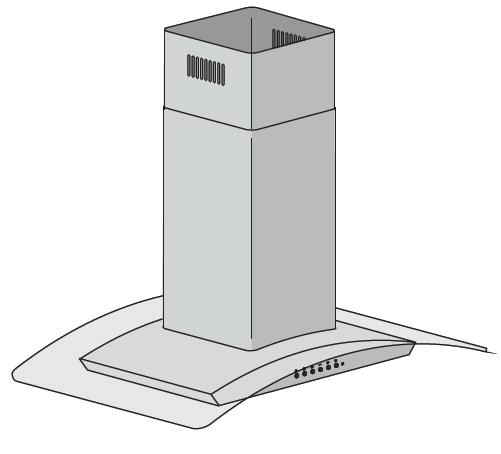 Please perform these steps:
Please perform these steps:
- Read the safety instructions.
- Read all instructions in the manual BEFORE operating the range hood.
- Remove all packing materials.
- Installation is to be done by a qualified technician only. However, the ultimate responsibility for proper installation falls to the owner.
- Product failure due to improper installation is not covered under the Warranty.
Hardware Note: For safety reasons, range hood mounting screws and anchors will not be included due to the variation of cabinetry constructions and wall material. Please consult your installation specialist regarding the optimal type of mounting screws and wall anchors to suit your home’s construction.
Important Safety Information
READ ALL INSTRUCTIONS BEFORE USE
Read and follow all instructions before using the range hood to prevent the risk of fire, electric shock, personal injury, or damage when using the range hood or appliances with the range hood. This guide does not cover all possible conditions that may occur. Always contact your service technician or manufacturer about problems that you do not understand.
- The installation in this manual is intended for qualified installers, service technicians or persons with a similar qualified background. Installation must be done by qualified professionals and in accordance with all applicable codes and standards, including fire-rated construction.
- The range hood may have very sharp edges; please wear protective gloves if it is necessary to remove any parts for installing, cleaning or servicing.
- Activating any switch to ON position before completing installation may cause damage or electric shock.
- Due to the size of this range hood, a two person installation is recommended.
To reduce the risk of fire, electric shock, or injury to persons:
- For general ventilating use only. DO NOT use to exhaust hazardous or explosive materials and vapors.
- WARNING: To Reduce The Risk Of Fire Or Electric Shock, Do Not Use This Fan With Any Solid-State Speed Control Device.
- The combustion air flow needed for safe operation of fuel-burning equipment may be affected by this unit’s operation. Follow the heating equipment manufacturer’s guideline and safety standards such as those published by the National Fire Protection Association (NFPA), and the American Society of Heating, Refrigeration and Air Conditioning Engineers (ASHRAE), and other local code authorities.
- Before servicing or cleaning the unit, switch power off at service panel and lock the service disconnecting means to prevent power from being switched on accidentally. When the service disconnecting means cannot be locked, securely fasten a prominent warning device, such as a tag, to the service panel.
- Clean grease-laden surfaces frequently. To optimize performance and to disperse air properly, make sure to vent air outside. DO NOT vent exhaust into spaces between walls, crawl spaces, ceilings, attics or garages.
- Ducted fans MUST always be vented to the outdoors.
- This unit MUST be grounded and used with metal ductwork only.
- Sufficient air is needed for proper combustion and exhausting of gases through the duct to prevent back drafting.
- When cutting or drilling into wall or ceiling, be careful not to damage electrical wiring or other hidden utilities.
- All electrical wiring must be properly installed, insulated and grounded.
- Old ductwork should be cleaned or replaced if necessary to avoid the possibility of a grease fire.
- Check all joints on ductwork to ensure proper connection; all joints should be properly taped using a certified aluminum or foil tape.
- Use this unit only in the manner intended by the manufacturer. If you have questions, contact the vendor.
WARNING: TO REDUCE RISK OF A RANGE TOP GREASE FIRE:
- a) Never leave surface units unattended at high settings. Boilovers cause smoking and greasy spillovers that may ignite. Heat oils slowly on low or medium settings.
- b) Always turn range hood ON when cooking at high heat or when flambéing food (i.e. Crepes Suzette, Cherries Jubilee, etc.).
- c) Clean ventilating fans frequently. Grease should not be allowed to accumulate on fan or filter. Before servicing or cleaning unit, unplug and disconnect the hood from the power supply.
- d) Use proper pan size. Always use cookware appropriate for the size of the surface element.
WARNING: TO REDUCE RISK OF INJURY TO PERSONS IN THE EVENT OF A RANGE TOP GREASE FIRE, OBSERVE THE FOLLOWING *
- a) SMOTHER FLAMES with a close-fitting lid, cookie sheet, or metal tray, then turn off the burner. BE CAREFUL TO PREVENT BURNS. If the flames do not go out immediately, EVACUATE AND CALL THE FIRE DEPARTMENT.
- b) NEVER PICK UP A FLAMING PAN – You may be burned.
- c) DO NOT USE WATER, including wet dishcloths or towels – a violent steam explosion will result.
- d) Use an extinguisher ONLY if:
- 1) You know you have a Class A, B, C extinguisher, and you already know how to operate it.
- 2) The fire is small and contained in the area where it is started.
- 3) The fire department is being called.
- 4) You can fight the fire with your back to an exit.* Based on “Kitchen Fire Safety Tips” published by NFPA
To reduce the risk of injury to persons in the event of a gas leaks:
- Extinguish any open flame.
- DO NOT turn on the lights or any type of appliance.
- Open all doors and windows to disperse the gas. If you still smell gas, call the gas company and fire department.
Your safety and the safety of others is very important. We have provided many important safety messages in this manual and on your appliance. Always read and obey all safety messages. All safety messages outline any potential hazards, how to reduce the chance of injury, and possible risks if the instructions are not followed.
Included Parts
Hardware Note: For safety reasons, range hood mounting screws and anchors will not be included due to the variation of cabinetry constructions and wall material. Please consult your installation specialist regarding the optimal type of mounting screws and wall anchors to suit your home’s construction.
Range Hood Dimensions
Specifications
| Body Design | Stainless Steel |
| Power Rating | 120 V / 60 Hz (cULus Certified) |
| Total Input Power | 220 W (210 W + 4 × 2.5 W) |
| Motor Input Power | 210 W |
| Total Amps | 1.8 A |
| Speed Control Levels | 3 Levels |
| Interference Levels | Radio Frequency Interference Protected |
| Motors | Single Motor |
| Control | Electronic control panel |
| Filtration | Decorative Filters |
| Illumination | 4 × 2.5 W LED |
| Fan Type | Single Chamber Quiet |
| Venting Size | Top 6 inches (15.3 cm) round |
Mounting Bracket
Installation
STEP 1: Read the Safety Instructions
It is very important to read the safety instructions on pages 4 and 5.IMPORTANT: It is the installer’s responsibility to comply with installation clearances.
STEP 2: Unpack Range Hood and Prepare Tools
- Carefully unpack the range hood and parts. Make sure all parts are included as shown on page 6.
- DO NOT remove the protective film covering the appliance until the installation is fully completed.
- Consult a qualified and trained installer or check local codes for makeup air requirement, if any.
STEP 3: Plan Desired Location
- Designed for ceiling heights between 8.8 ft. to 9.5 ft. (2.6 – 2.9 m) only. Refer to Height and Clearance section.
- Plan a desirable location that fits all requirements in the Safety and Installation sections of this manual. Plan where and how the ductwork will be installed.
- A straight or short duct run will allow the unit to perform most efficiently. Long duct runs, elbows and transitions will reduce the performance of the unit. Each elbow is equivalent to 5 to 10 feet (1.5 m to 3 m) of straight run. Proper size duct work should be 6 in. (15.3 cm) in diameter.
- To reach a 9 foot ceiling make sure hood is installed 30 in. (76.2 cm) from cooking surface.
- If ductwork is already installed, ensure ductwork is free from debris and measures 6 in. (15.3 cm).
- Install a 120 V 60 Hz electrical outlet on the ceiling within the dimensions of the decorative chimney. Note: Removal of the plug will void the warranty of the range hood.
- Note that the bottom of the bracket must be level to ensure that the island range hood hangs level.
STEP 4: Test Unit Functions
- Plug the unit in and test all of the functions before installing.
- Place the range hood on a flat, stable surface. Connect the range hood to a designated standard outlet (120-Volt, 60Hz, AC only) and turn on the range hood. Verify all operations of the range hood by referring to Range Hood Operations.
- Turn power On in control panel.
- Check all lights and fan operations.
WARNINGS:
- Please make sure to read ALL safety instructions on pages 4 and 5.
- Use two or more people to move and install range hood.
- Failure to follow these instructions can result in serious injury.
STEP 5: Venting Installation Guidelines
The following steps are for exterior ventilation.Height and Clearance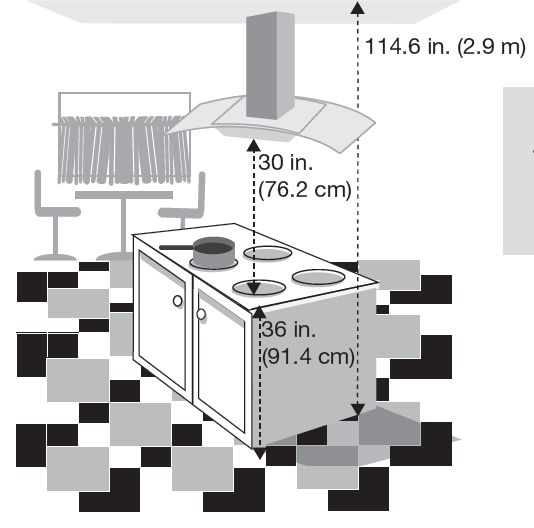
Maximum ceiling clearance 114.6 in. (2.9 m) at 30 in. (76.2 cm) hood mounting height above countertop or stove (May vary with different model). Chimney extensions available for higher ceiling.
IMPORTANT:
- Vent system must terminate to the outside (roof or side wall).
- DO NOT terminate the vent system in an attic or other enclosed area.
- DO NOT use 4 in (10.2 cm) laundry-type wall caps.
- Use metal/aluminum vent only. A rigid metal/aluminum vent is recommended.
- DO NOT use a plastic vent.
- Always keep the duct clean to ensure proper airflow.
- Calculate the following figures before installation:1. Distance from the floor to the ceiling2. Distance between the floor and the countertop/stove3. A distance of 24 in to 30 in (61 cm to 76.2 cm) is recommended between stove top and the bottom of range hood. 30 in (76.2 cm) minimum is required for gas stove tops.4. Height of hood and duct cover.
For the most efficient and quiet operation:
- It is recommended that the range hood be vented vertically through the roof through 6 in. (15.3 cm) or bigger round metal/aluminum vent work.
- The size of the vent should be uniform.
- Use no more than three 90° elbows.
- Make sure there is a minimum of 24 in (61 cm) of straight vent between the elbows if more than one elbow is used.
- DO NOT install two elbows together.
- The length of vent system and number of elbows should be kept to a minimum to provide efficient performance.
- The vent system must have a damper. If roof or wall cap has a damper, you may remove damper flaps from damper to increase air flow.
- Only one flange is needed in the air duct system, either on top of the motor or outside.
- Use silver tape or duct tape to seal all joints in the vent system.
- Use caulking to seal exterior wall or roof opening around the cap.
IMPORTANT:
- A minimum of 6 in. (15.3 cm) round or 3-1/4 × 10 in. (8.3 cm × 25.4 cm) rectangular duct must be used to maintain maximum airflow efficiency.
- Always use rigid type metal/aluminum ducts if available to maximize airflow when connecting to provided duct.
- Please use Duct Run Calculation below to compute total available duct run when using elbows, transitions and caps.
- ALWAYS, when possible, reduce the number or transitions and turns. If long duct run is required, increase duct size from 6 in. (15.3 cm) to 7 in. (17.7 cm) or 8 in. (20.3 cm). If a reducer is used, install a long reducer instead of a pancake reducer. Reducing duct size will restrict airflow and decrease airflow, thus reduce duct size as far away from opening as possible.
- If turns or transitions are required, install as far away from opening and as far apart, between two (2), as possible.
- Minimum mount height between stove top to hood bottom should be no less than 24-inch (61 cm) for electric cook tops and minimum of 30-inch (76.2 cm) for gas stove tops and no higher than 30-inch (76.2 cm) for electric cook tops.
- It is important to install the hood at the proper mounting height. Hoods mounted too low could result in heat damage and fire hazard; while hoods mounted too high may be hard to reach and will lose its performance and efficiency.
- If available, also refer to stove top manufacturer’s height clearance requirements and recommended hood mounting height above range.
- This range hood is factory set for venting through the roof or wall.
- Vent work can terminate either through the roof or wall. To vent through a wall, a 90° elbow is needed.
- NEVER exhaust air or terminate duct work into spaces between walls, crawl spaces, ceiling, attics or garages. All exhaust must be ducted to the outside.
- Use metal/aluminum duct work only.
- Fasten all connections with sheet metal screws and tape all joints with certified Silver Tape or Duct Tape.
- Use caulking to seal exterior wall or roof opening around the cap.

STEP 6: PreparationsNOTE: To avoid damage to your hood, prevent debris from entering the vent opening.NOTE: Use threaded drywall anchors only when mounting the hood on sheet rock. Mounting the hood on wall studs or lumbers is highly recommended.
- Determine and mark the centre line on the ceiling where the range hood will be installed. A distance of 24 inches to 30 inches from the stove top is recommended, with a minimum of 30 inches for gas stove tops.
- Make sure there is proper clearance within the ceiling for exhaust vent.
- Due to the weight and size of this unit, please make sure that the support system or framework being used is stable and secure in the ceiling.
- Put a thick, protective covering over counter top, cook top or range to protect from damage or dirt.
- Remove any hazardous objects around the area when installing.
CAUTION: If moving the cooking range is necessary to install the hood, turn OFF the power on an electric range at the main electrical box. SHUT OFF THE GAS BEFORE MOVING A GAS RANGE.
STEP 7: Installing the hood mounting bracket
- The ceiling must be able to bear at least 40 kg (88 lbs.) of weight, and the thickness of the ceiling must be at least 3 cm (1.8 in.).
- Drill a 17 cm (6.7 in.) round hole in the ceiling.
- Run house electrical wires to the electrical box on the bracket. Black to Black, White to White, and Green to Green or Bare Wires.
- In line with the hanging board, drill 8 holes in the ceiling (see Figure #1).
- Using appropriate explode screws, attach the hanging board to the ceiling (see Figure #1).

- Calculate the total length of the angle iron required so that the overlap angle iron is no less than 10 cm (3.94 in.) and that the distance from the bottom of the range hood and the cooking surface is between 61 to 76 cm (24 in. to 30 in.).
- Attach the 2 sections of the angle iron together for each corner using supplied 16 pieces M4×10 mm mounting screws with nuts and washers (see Figure #2).
- Use 8 pieces M4×10 mm mounting screws to attach the angle iron into the hanging board (see Figure #2).

STEP 8: Venting
- Fix the damper on the top vent of hood (see Figure #3).

- Let the ducting pipe go inside through the hole from the ceiling (see Figure #4).

- Measure the length of 6 in. round metal duct required from the damper / duct connector to the ductwork rough-in in the ceiling. Connect the duct to the duct connector and seal with duct tape.
STEP 9: Electrical
- Remove the protective coating from the upper chimney. Carefully slide the upper chimney down into the lower chimney. Slide the chimneys over the angle brackets.
- Feed the electrical wires up through the chimneys (see Figure #5).

STEP 10: Finishing Installation
Note: To avoid personal injury and/or damage to the range hood, this installation step requires three people.
- Use 4 pieces ST4 × 8 mm mounting screws to attach the upper chimney into the hanging board and hold up the lower chimney with the supplied `S` hook (see Figure #6).

- Use 4 pieces M4 × 25 mm mounting screws with washers to attach the glass into the hood (see Figure #7).

- Use 16 pieces M4 × 10 mm mounting screws to attach the hood into angle irons (see Figure #8).

- Attach the ducting pipe on the outlet (see Figure #9).

- After finishing all the above installation steps, remove the `S` hook and put down the lower chimney (see Figure #10).

IMPORTANT:
- Observe all governing codes and ordinances.
- It is the customer’s responsibility to contact a qualified electrical installer.
- If codes permit and a separate ground wire is used, it is recommended that a qualified electrician determine that the ground path is adequate. A 120-Volt, 60 Hz, AC-only, fused electrical supply is required on a separate 15-amp circuit, fused on both sides of the line.
- DO NOT ground to a gas pipe.
- Check with a qualified electrician if you are not sure that the range hood is properly grounded.
- DO NOT have a fuse in the neutral or ground circuit.IMPORTANT: Save this Installation Guide for electrical inspector’s use.
GROUNDING INSTRUCTIONS:
- This appliance must be grounded. In the event of an electrical short-circuit, grounding reduces the risk of electric shock by providing an escape wire for the electric current.
- The range hood must be connected with copper wire only.
- The range hood should be connected directly to the fused disconnect (or circuit breaker) box through flexible armored or non-metallic sheathed copper cable. UL/CSA listed strain relief must be provided at each end of the power supply cable.
STEP 11: Install Filters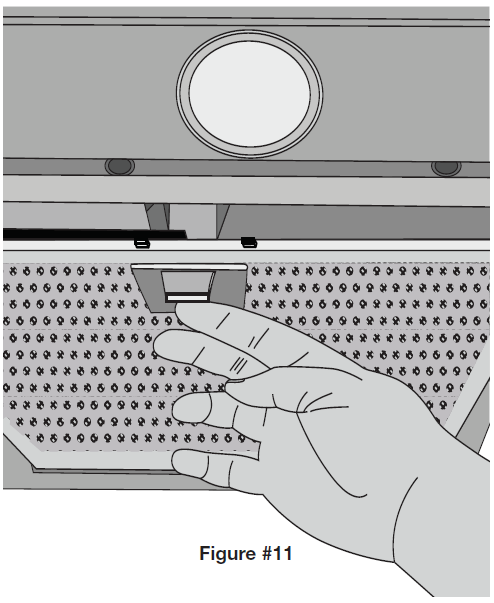
- Angle the filter into the slots at the back of the hood.
- Open handle on the filter.
- Release the handle once the filter fits into a resting position.
- Repeat to install all filters.
- The baffle filters channel grease released by cooking foods and prevent flaming foods on the cook top from damaging the inside of the range hood. For this reason, the baffle filters must ALWAYS be installed during range hood use.
- The baffle filters should be cleaned once a month, or as needed. See page 17 for cleaning instructions.
Maintenance
Cleaning the Range HoodBe sure electrical power is off and all surfaces are cool before cleaning or servicing any part of the hood.
Proper maintenance of the Range Hood will ensure proper performance of the unit.Use a warm detergent solution. Grease filters are dishwasher safe.Stainless steel is one of the easiest materials to keep clean. Occasional care will help preserve its appearance.
Cleaning tips:
- Hot water with soap or detergent is all that is usually required.
- Follow all cleaning by rinsing with clear water. Wipe dry with a clean, soft cloth to avoid water marks.
- For discolorations or deposits that persist, use a non-scratching household cleanser or stainless steel polishing powder with a little water and a soft cloth.
- For stubborn cases, use a plastic scouring pad or soft bristle brush with cleanser and water. Rub lightly in direction of polishing lines or “grain” of the stainless finish. Avoid using too much pressure, which may mar the surface.
- DO NOT allow deposits to remain on surface for long periods of time.
- DO NOT use ordinary steel wool or steel brushes. Small bits of steel may adhere to the surface causing rust.
- DO NOT allow salt solutions, disinfectants, bleaches, or cleaning compounds to remain in contact with stainless steel for extended periods. Many of these compounds contain chemicals which may be harmful. Rinse with water after exposure and wipe dry with a clean cloth.
Painted surfaces should be cleaned with warm water and mild detergent only. 
Range Hood Assembly
| Number | Part |
| 1 | Box and cover of cord |
| 2 | Mounting bracket |
| 3 | Mounting angle |
| 4 | Upper chimney |
| 5 | Lower chimney |
| 6 | Power cord |
| 7 | Cover of electronic box |
| 8 | Capacitor |
| 9 | PCB |
| 10 | Base of electronic box |
| 11 | Round duct or valve (exhaust) |
| 12 | Glass |
| 13 | Housing assembly |
| 14 | Carbon filter lock plate |
| 15 |
Blower assembly (includes motor) |
| 16 | |
| 17 | |
| 18 | |
| 19 | |
| 20 | Panel |
| 21 | Bracket of switch |
| 22 | Cover of control box |
| 23 | Control board |
| 24 | LED puck lights |
| 25 | Decorative filter (2 pieces) |
| 26 | Screw bag |
Assembly
Circuit Diagram
Blower Assembly
| Number | Part |
| 1 | Grid |
| 2 | Motor |
| 3 | Impeller |
| 4 | Blower |
| 5 | Wind drum inlet |
Electrical Assembly
| Number | Part |
| 1 | Junction box cover |
| 2 | Capacitor |
| 3 | Main PCB board |
| 4 | Junction box bottom |
Troubleshooting
| Problem | Possible Cause |
| If the range hood or LED light does not operate after installation: | Check if the range hood has been plugged in, make sure that all power has been turned back ON, fused not blown and all electrical wiring are properly connected. |
| The range hood vibrates when the blower is on: | The range hood might not have been secured properly on to the ceiling. |
| The blower or fan seems weak: | Check that the duct sized used is at least 6 in. (15.3 cm) or 3 1/4 × 10 in. (8.3 × 25.4 cm). Range hood WILL NOT function efficiently with insufficient duct size. For example: 7 in. (17.7 cm) duct over 6 in. (15.3 cm) hole and loosely secured. |
| Check if duct is clogged or if damper unit (half-circular flange) is not installed correctly or opening properly. A tight mesh on a side wall cap unit might also cause restriction to the air flow. | |
| The lights work but the fan is not spinning at all, is stuck or is rattling: | The fan might be jammed or scraping the bottom due to shipping damage. Please contact us immediately. |
| The hood is not venting out properly: | Make sure the distance between the stove top and the bottom of the hood is within 24 in. and 30 in. (61 and 76.2 cm) in distance. |
| Reduce the number of elbows and length of duct work. Check if all joints are properly connected, sealed, and taped. |
Use and Care Information
Operations
- Read and understand all instructions and warnings in this manual before operating the appliance. Save these instructions for future reference.
- Always leave safety grills and filters in place. Without these components, operating fans could catch on to hair, fingers and loose clothing.
- NEVER dispose cigarette ashes, ignitable substances, or any foreign objects into fans.
- NEVER leave cooking unattended. When frying, oil in the pan can easily overheat and catch fire. The risk of self combustion is higher when the oil has been used several times.
- NEVER cook on “open” flames under the range hood. Check deep-fryers during use; superheated oil may be flammable.
Cleaning
- The saturation of greasy residue in the fan and filters may cause increased inflammability. Keep unit clean and free of grease and residue build-up at all times to prevent possible fires.
- Filters must be cleaned periodically and free from accumulation of cooking residue (see Cleaning Instructions below). Old and worn filters must be replaced immediately.
- DO NOT operate fans when filters are removed. Never disassemble parts to clean without proper instructions. Disassembly is recommended to be performed by qualified personnel only. Read and understand all instructions and warnings in this manual before proceeding.
SAFETY WARNING: Never put your hand into area housing the fan while the fan is operating!For optimal operation, clean range hood and all baffle/spacer/filter/grease tray/oil container regularly. Regular care will help preserve the appearance of the range hood.
Cleaning Exterior Surfaces
- Clean periodically with hot soapy water and clean cotton cloth. DO NOT use corrosive or abrasive detergent (e.g. Comet Power Scrub®, EZ-Off® oven cleaner), or steel wool/scoring pads, which will scratch and damage the stainless steel surface. For heavier soil use liquid degrease such as “Formula 409®” or “Fantastic®” brand cleaner.
- If hood looks splotchy (stainless steel hood), use a stainless steel cleaner to clean the surface of the hood. Avoid getting cleaning solution onto or into the control panel. Follow directions of the stainless steel cleaner. CAUTION: DO NOT leave on too long as this may cause damage to hood finish. Use soft towel to wipe off the cleaning solution, gently rub off any stubborn spots. Use dry soft towel to dry the hood.
- After cleaning, you may use non abrasive stainless steel polish such as 3M® or ZEP®, to polish and buff out the stainless luster and grain. Always scrub lightly, with clean cotton cloth, and with the grain.
- DO NOT allow deposits to accumulate or remain on the hood.
- DO NOT use ordinary steel wool or steel brushes. Small bits of steel may adhere to the surface and cause rusting.
- DO NOT allow salt solutions, disinfectants, bleaches, or cleaning compounds to remain in contact with stainless steel for extended periods. Many of these compounds contain chemicals, which may be harmful.
- Rinse with water after exposure to these compounds and wipe dry with a clean cloth.
 Canada & USAPhone: 1-888-686-0778Fax: 800-350-8563Email: [email protected]Website: wwwanconahome.com
Canada & USAPhone: 1-888-686-0778Fax: 800-350-8563Email: [email protected]Website: wwwanconahome.com
[xyz-ips snippet=”download-snippet”]

